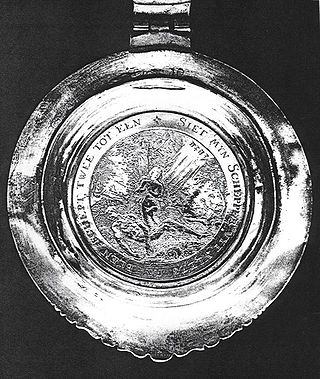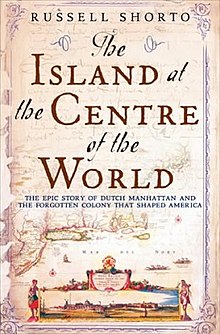
The Raritan are two groups of Lenape people who lived around the lower Raritan River and the Raritan Bay, in what is now northeastern New Jersey, in the 16th century.
Willem Verhulst or Willem van Hulst was an employee of the Dutch West India Company and the second (provisional) Director of the New Netherland colony in 1625–26. Nothing can be verified about his life before and after this period. Verhulst may have consummated the purchase of Manhattan Island on behalf of the Dutch West India Company, although there is still considerable debate over the evidence that also supports the purchase by Peter Minuit.

Willem Kieft, also Wilhelm Kieft, was a Dutch merchant and the Director of New Netherland from 1638 to 1647.
This is a list of Directors, appointed by the Dutch West India Company, of the 17th century Dutch province of New Netherland in North America. Only the last, Peter Stuyvesant, held the title of Director General. As the colony grew, citizens advisory boards – known as the Twelve Men, Eight Men, and Nine Men – exerted more influence on the director and thus affairs of province.

Russell Anthony Shorto is an American author, historian, and journalist who is best known for his book on the Dutch origins of New York City, The Island at the Center of the World. Shorto's research for the book relied greatly on the work of the New Netherland Project, now known as the New Netherland Research Center, as well as the New Netherland Institute. Shorto has been the New Netherland Institute's Senior Scholar since 2013.

Adriaen Cornelissen van der Donck was a lawyer and landowner in New Netherland after whose honorific Jonkheer the city of Yonkers, New York, is named. Although he was not, as sometimes claimed, the first lawyer in the Dutch colony, Van der Donck was a leader in the political life of New Amsterdam, and an activist for Dutch-style republican government in the Dutch West India Company-run trading post.
The New Netherland Institute is a non-profit organization created to support the translation and publication of 17th-century Dutch documents from the period of the Dutch colonization of New Netherland.
Colen Donck was a 24,000 acre (97 km2) patroonship in New Netherland along the southern Hudson River in today's Bronx and Yonkers established by Dutch-American lawyer and land developer Adriaen van der Donck.
House of Hope, also known as Fort Good Hope, was a redoubt and factory in the seventeenth-century Dutch colony of New Netherland. The trading post was located at modern-day Hartford, Connecticut at Park River), a tributary river of the Fresh River. The location of this confluence of rivers is at contemporary Sheldon Street. The fort is recalled today with a nearby avenue called Huyshope, once the center of economic activity in the city.

Sarah Rapelje was the first European Christian female, the "first white child" born in New Netherland.

Vriessendael was a patroonship on the west bank of the Hudson River in New Netherland, the seventeenth century North American colonial province of the Dutch Empire. The homestead or plantation was located on a tract of about 500 acres (2.0 km2) about an hour's walk north of Communipaw at today's Edgewater. It has also been known as Tappan, which referred to the wider region of the New Jersey Palisades, rising above the river on both sides of the New York/New Jersey state line, and to the indigenous people who lived there and were part of wider group known as Lenape. It was established in 1640 by David Pietersen de Vries, a Dutch sea captain, explorer, and trader who had also established settlements at the Zwaanendael Colony and on Staten Island. The name can roughly be translated as De Vries' Valley. De Vries also owned flatlands along the Hackensack River, in the area named by the Dutch settlers Achter Col. Parts of Vriessendael were destroyed in 1643 in reprisal for the slaughter of Tappan and Wecquaesgeek Native Americans who had taken refuge at Pavonia and Corlears Hook. The patroon's relatively good relations with the Lenape prevented the murder of the plantation's residents, who were able to seek sanctuary in the main house, and later flee to New Amsterdam. The incident was one of the first of many to take place during Kieft's War, a series of often bloody conflicts with bands of Lenape, who had united in face of attacks ordered by the Director of New Netherland.

Jacques Cortelyou was an influential early citizen of New Amsterdam who was Surveyor General of the early Dutch colony. Cortelyou's main accomplishment was the so-called Cortelyou Survey, the first map of New York City, commonly called the Castello Plan after the location in a Tuscan palace where it was rediscovered centuries later.
Cornelis Melyn was an early Dutch settler in New Netherland and Patroon of Staten Island. He was the chairman of the council of eight men, which was a part of early steps toward representative democracy in the Dutch colony.

New Netherlanders were residents of New Netherland, the seventeenth-century colonial outpost of the Republic of the Seven United Netherlands on the northeastern coast of North America, centered on the Hudson River and New York Bay, and in the Delaware Valley.

Jan Evertsz Bout, was an early and prominent Dutch settler in the 17th century colonial province of New Netherland.
Joris Jansen Rapelje was a member of the Council of Twelve Men in the Dutch West India Company colony of New Netherland. He and his wife Catalina (Catalyntje) Trico (1605–1689) were among the earliest settlers in New Netherland.

Everardus Bogardus was the dominie of the New Netherlands, and was the second minister of the Dutch Reformed Church, the oldest established church in present-day New York, which was then located on Pearl Street at its first location built in 1633, the year of his arrival. Bogardus was, in fact, the second clergyman in all of the New Netherlands.
Princess Amelia was a Dutch merchant ship of 38 guns and 600 tons (bm) built in 1634 and wrecked off Swansea, Bristol Channel, in 1647. She served the Dutch West India Company and was one of the largest merchant ships of her day with 38 guns.










